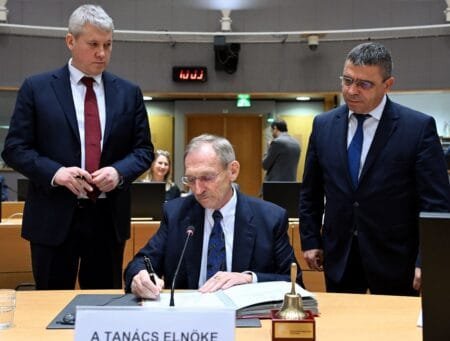The European Commission on 13 February 2008 presented a Communication on the creation of a European Border Surveillance System (EUROSUR), with the main purpose of preventing unauthorised border crossings, reducing the number of illegal immigrants loosing their life at sea and increasing the internal security of the EU by contributing to the prevention of cross-border crime.
Advertisement
The Communication examines the parameters within which a European Border Surveillance System (EUROSUR), focussing initially on the southern and eastern external borders of the EU, could be developed and suggests to Member States a roadmap for gradually developing such a “system of systems” over the coming years. This Communication focuses on enhancing border surveillance, with the purpose to
For the time being, national border surveillance systems are covering only selected parts of the EU external borders. Due to technical and financial limitations, the areas covered by surveillance are currently restricted to certain flat or coastal areas and those areas in which operations are carried out.
The authorities responsible for border control in the Member States need to be provided with more timely and reliable information if they are to detect, identify, track and intercept those attempting to enter the EU illegally, thereby reducing the number of illegal immigrants crossing the external borders of the EU undetected.
Many illegal immigrants and persons in need of international protection are travelling in conditions of extreme hardship and are taking great personal risks in their attempts to enter the EU illegally by hiding in vehicles, on cargo vessels, etc. The recent practice of travelling on board of unseaworthy and overcrowded boats, has multiplied the number of unfortunate migrants who continue to lose their lives by drowning in the Atlantic Ocean between Africa and the Canary Islands and in the Mediterranean Sea.
The tragic death toll resulting from this kind of illegal immigration is unacceptable and must therefore be significantly reduced. The capacity to detect small boats in the open sea must be enhanced, contributing to greater chances of search and rescue and thereby saving more lives at sea. However, long-term solutions to the challenges posed by migration management can only be achieved through a comprehensive strategy that includes cooperation with third countries, also on border surveillance.
Border surveillance has not only the purpose to prevent unauthorised border crossings, but also to counter cross-border crime such as the prevention of terrorism, trafficking in human beings, drug smuggling, illicit arms trafficking etc.
To counter these threats is first and foremost a task for the police forces and intelligence services of Member States. However, an effective border management system both at national and European level will provide a valuable tool for fighting cross-border crime.
A European Border Surveillance System (EUROSUR) should support the Member States in reaching full at their external borders and in increasing the of their law enforcement authorities.
EUROSUR should provide the common technical framework for streamlining the daily cooperation and communication between Member States’ authorities and facilitate the use of state-of-the-art technology for border surveillance purposes. A key operational objective should be the sharing of information, excluding personal data, between existing national and European systems.
EUROSUR could be set up in three, parallel on-going phases:
- PHASE 1: The aim of this phase is to interlink and streamline existing surveillance systems and mechanisms at Member State level.
Therefore funding provided under the European External Borders Fund should be used to upgrade and extend the national border surveillance systems and to set up national coordination centres for border control in the Member States located at the southern and eastern external borders of the EU.
A secured computerised communication network should be set up in order to exchange data and coordinate activities between the centres in the Member States as well as with the FRONTEX Agency.
Furthermore, it should be explored how financial and logistical support could be given to selected neighbouring third countries to promote operational cooperation on border surveillance with Member States.
- PHASE 2: The purpose of this phase is to make better use of surveillance tools at EU level.
By using the EU programmes for research and development, the technical performance of surveillance tools and sensors (e.g. satellites, unmanned aerial vehicles, etc.) shall be improved.
Furthermore, a common application of surveillance tools would provide Member States authorities with surveillance information on their external borders and the pre-frontier area on a more frequent and reliable basis.
Finally, a common pre-frontier intelligence picture could be developed to combine intelligence information with that obtained from surveillance tools.
- PHASE 3: The objective of this phase is to create a common information sharing environment for the EU maritime domain. This shall be done by integrating all existing reporting and monitoring systems in sea areas under the jurisdiction of the Member States and in adjacent high seas into a broader network, thus allowing border control authorities to take advantage of the combined use of these various systems.
Taking into account the current migratory pressure, in a first step the integrated network should be limited to the Mediterranean Sea, the southern Atlantic Ocean (Canary Islands) and the Black Sea and focus on internal security, linking border control authorities and other authorities with security interests and responsibilities in the maritime domain together.
At a later stage, this integrated network of reporting and surveillance systems could be extended to the whole maritime domain of the EU, covering not only border related aspects, but all maritime activities, such as maritime safety, protection of the marine environment, fisheries control, and law enforcement.
Whereas phases 1 and 2 should cover the maritime and land external borders, phase 3 should focus on the maritime domain only. The aspects of this Communication dealing with the surveillance of maritime external borders form part of the overall framework set by the Integrated Maritime Policy for the European Union.
Once implemented, EUROSUR would constitute a decisive step in the further gradual establishment of a common European integrated border management system. When implementing the different measures described in this Communication, the External Borders Fund should be the main solidarity mechanism for the Member States in sharing the financial burden in the European Union.





